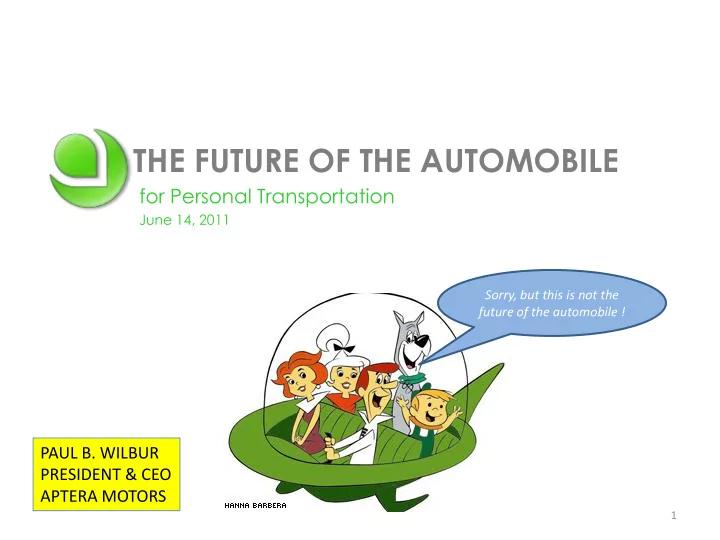

THE FUTURE OF THE AUTOMOBILE for Personal Transportation June 14, 2011 Sorry, but this is not the future of the automobile ! PAUL B. WILBUR PRESIDENT & CEO APTERA MOTORS 1
U.S. CAFÉ Standards for Passenger Cars… 70 Revolution 60 50 Evolution (?) 40 Standard 30 Higher Std 20 Very few changes in Today! fuel economy over the past 20 years 10 0 1980 1985 1990 1995 2000 2005 2010 2015 2020 2025 2030 2035 2040 2
The Aptera approach is based on “first principles” No, not Angus MacKenzie … This is Sir Isaac Newton ! It’s back to Newtonian physics… 3
The automobile and Physics 101 A vision for all vehicles in the future – must consider all of the forces on a vehicle… Aerodynamic Lift Aero drag Braking forces Motive Force Rolling resistance Other friction related FRONT The Auto Union Type C- 16 “Silver Arrow” Aerodynamic down force Weight & Grade (effects of gravity) 4
The automobile and Physics 201 The power required for a vehicle to overcome the force of aerodynamic drag is … Power Drag = ½ ρ v 3 C D A Since energy used is a function of the cube of velocity times the form of the drag area. The faster we go, the power required also goes up by the cube of the velocity… aerodynamics become mission critical, esp. in freeway driving 5 Where r is the density of air – so we aren’t going to impact that one too much…
The automobile and Physics 301 The power required to accelerate a vehicle … Power accelerate = (( 1/2 m v 2 )/t) Where m = mass; v = final speed; t = time Energy to accelerate is a function of the mass of the vehicle and how anxious the driver is to get where he’s going. The faster we go is a squared function of the power that must be used . Therefore, Low Mass is critical, especially in City based start and stop driving and that is most of the driving that most Americans do… 6
The Final Physics Class - Ph962 Reduce the FRICTIONAL LOSSES and there are many… 7
NOW - If we can’t change the speeds that we drive or the way we accelerate away from a stop light, we MUST find our energy savings in the fundamental - physical attributes of the automobile … There are 4 essential „building blocks‟ that must be considered critical in the design of future, more efficient passenger vehicles. 8
A Physics Lesson for all OEMs APTERA believes these factors are absolutely critical to consider when designing the next generation of ultra fuel efficient vehicles: Aptera‟s Engineering Approach 1. Low mass materials Fully composite , monocoque body (not CF) which is 3X stronger than steel 2. Aerodynamic forms Coefficient of drag roughly ½ of all existing vehicles on the road today 3. Regenerative braking Recapturing “energy” during (true power train efficiency) deceleration using electric drive!!! instead of an ICE drive train. 4. Lower rolling resistance To reduce frictional losses everywhere (electric motor is 94% efficient, 1 speed direct drive transaxle with electric park pawl, high efficiency wheel bearings, brake pads with spring back function, low RR tires, electric steering, 9 electric compressor vs serpentine belts, etc.)
The Aptera Formula • Aer erodynamic odynamics - Drives energy consumption at high speeds • Wei eight - Drives energy consumption at low speeds • Safety fety - A requirement in the vehicle purchase decision 10
Aptera‟s Mission To design, manufacture and sell vehicles that set a new benchmark in “energy efficiency”! Argonne National – Labs certified this level of “fuel efficiency” in our “proof of concept” vehicle in September of 2010. On the same basis: – Nissan Leaf achieves • - 99 MPG-e (as an electric) Chevy Volt achieves • All Aptera vehicles > 200 MPG-e (EPA) - 93 MPG-e (electric only) but only 37 MPG (in gas mode) 11
Where must we look for fuel economy as the CAFÉ standards rise significantly? Market penetration of new technologies for light-duty vehicles, 2008 and 2035 per EIA 2008 2035 Drag reduction Material substitution Aggressive shift logic Not needed for a one speed transaxle electric vehicle Turbocharging N/A for an EV – ICE engines only Advanced transmission N/A for an EV w/ 1 speed Trans unless CVT optimized to peak electric motor specs. Camless valve activation Anyone for Mr. Fusion? N/A for an EV – ICE engines only Accessory improvements 0 20 40 60 80 100 Percent market share 12 Source: Annual Energy Outlook 2010
Don’t Laugh “One thing is clear: the era of easy oil is over. What we all do next will determine how well we meet the energy needs of the entire world in this century and beyond.” – David J O‟Reilly, Chairman & CEO, Chevron Corp, July 2005 “The Stone Age ended before the world ran out of stone and the oil age will end before the world runs out of oil! ” -Paul Wilbur, CEO Aptera, July, 2009 13
The Automobile Company of the Future 14
Recommend
More recommend